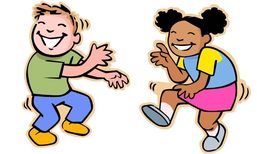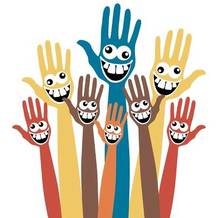When I think about why and how I do my work, the value I connect with most is curiosity. But there’s also a value I connect with that we don’t normally name – laughter.
Last year I was working with a student who repeatedly had conflicts with another student at their table. He would sometimes laugh at her, call her name and make a face. I noticed that the other student started telling him to stop – even at times when he hadn’t done anything. I asked the student. Why were you laughing? And he said "She always laughs with [other student] but gets mad when I laugh." That was the first time I realized – he was doing this because he wanted to get along with her – yet his action was having the opposite effect.
I helped the first student explain to the second that he wanted to laugh with her and have fun with her like the rest of the table did. I tried to explain the difference between laughing at someone and laughing with someone in a more positive and pro-social manner. But there are many social nuances of laughter than you probably wouldn’t think of unless you tried to explain them to first graders who are still learning how to engage with peers. You shouldn't laugh when someone falls down, but sometimes you can like if they're laughing. You shouldn't laugh at someone else, but sometimes people do something on purpose so you can laugh. You can tell a good time to laugh if a lot of other people are laughing, but not always, because sometimes people are doing it in a mean way.
Then I decided to show them one positive way to laugh with others. I didn’t have much so I just decided to do the first time that popped into my mind which was diving in to some weird dance moves. They looked at me, looked down at their feet, thought “this teacher is weird, I want to go to lunch” until they made eye contact with each other and started giggling. One of them started to dance, then the other once, then we were all laughing. We started laughing even more when the general education teacher walked back into the room.
Having that shared experience and creating that environment allows you to positively connect with another and to have an emotional response – one associated with both vulnerability and safety. I think the more moments you have like that with another person, the more automatically you’ll think of them in a positive way – and the more automatically you could assume they have a positive intention in social interactions.
This shared laughter can help the students to learn empathy – I noticed the student more often saying “Hi” to the other student at their classroom table or smiling in his direction. Her assumption changed from, this student is trying to bother me, to this student might be looking at me because he wants to talk to me. When you’re in a safe social environment, it’s easier to think and understand that all are there to support you.
There is this social value to shared laughter and I also recently read an article that also described laughter as having educational value. This was the first time I thought about laughter in the context of formal schooling, although then I thought back to my most memorable teachers and school experiences. They all had something in common – which was that class was fun and engaging – and the teachers used, in part, laughter to do that.
A particular part of the article struck me to the point where I just audibly and loudly exclaimed “wow” in Starbucks. Joris Vlieghe wrote: “Schools and other pedagogical institutions select and rank students on the basis of their own possibilities in order to get the right person in the right place in the adult world. Formal education is structured [to] mirror and support societal order.” It requires students to have a distinct position among each other. But “this ordering of individual and collective lives may be suspended at any time, because there is always the possibility that students and or teachers burst out laughing together and thus undergo a bodily experience that is profoundly equaling.”
I was working with a student once and he had just received a reward in class and was making things out of clay. He invited me to join so I did. He was quite the expert and made a shark, while I attempted the same. At the end, he asked to see mine and it was extraordinarily clear that his clay skills were much better than mine. He said a slight “oh” when he saw it and I couldn’t help but laugh. He started laughing too and I remember feeling as we were laughing that we were laughing longer than we should. But I decided not to stop it; instead I embraced how contagious it was. It switched from a laugh purely out of humor and one to something even stronger, where I was aware of the physical effect on my body. I felt calmer and less stress on my body. I felt more confident. I think in this work and particularly for me, stress can lead to indecision and questioning of myself and how I am doing my job.
This laughing episode came at a time of day when this student had received many directions and was not pleased with the sound of my voice, particularly when it was the one saying he had to miss recess. I kept the laughter going, feeling like not only did this stress release feel good for me, but probably also for my student. And it also gave us the space to enjoy each other. It demonstrates to the student unconditional positive regard – that you are there to support them, regardless of the behavior they are showing. There is unconditional care and support. I think when these positive interactions happen with our students, it can also provide a more positive association in their heads when they think of us. I think it does the same for me. (Although the transition out of laughter took a bit longer, it was possible with some breathing exercises….).
Laughing at yourself gives you a certain power when you make a mistake or do something wrong. And students can be taught that as well from a young age - that making a mistake doesn't mean you're a failure. Especially at that age, it means you're growing. When you laugh at a mistake, it creates a positive feeling associated with that mistake, so your automatic reaction when you make a mistake is not to feel shame - but rather feel something more positive. This can help shift students’ internal working model – from “I am a failure” or “I can’t do it” to “I made a mistake and I can fix it” or “I don’t understand but I can learn.”
And laughing with others, in a collective social setting, especially one where laughter is not common, creates a safe environment. An environment based off of mutual understanding and respect as well as enjoyment. I think this experience of shared/social laughter and incorporating laughter in school can also be a practice in healing trauma. It brings humanity and interconnectedness with others into the practice of teaching.
Ted talk:
https://www.ted.com/talks/charlie_todd_the_shared_experience_of_absurdity?language=en
Article on educational value of laughter:
https://doi-org.proxy.lib.duke.edu/10.1080/00131857.2012.721733



 RSS Feed
RSS Feed